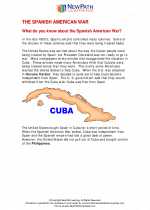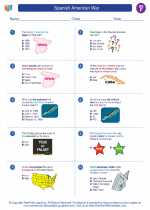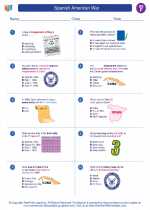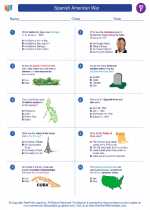Causes of the Spanish-American War
The main causes of the Spanish-American War included:
- Cuban War for Independence: The Cuban people were fighting for independence from Spanish colonial rule, and the brutal tactics of the Spanish military garnered sympathy in the United States.
- Yellow Journalism: Sensationalist newspaper reporting, particularly by William Randolph Hearst and Joseph Pulitzer, exaggerated Spanish atrocities in Cuba, swaying public opinion towards intervention.
- USS Maine Explosion: The explosion of the USS Maine in Havana Harbor, though not proven to be caused by Spain, led to a rallying cry of "Remember the Maine, to Hell with Spain!"
Key Events of the War
Some key events of the Spanish-American War include:
- Battle of Manila Bay: In the Pacific, Commodore George Dewey's naval victory over the Spanish fleet in the Philippines was a major early success for the United States.
- Rough Riders in Cuba: Theodore Roosevelt and his volunteer cavalry unit, the Rough Riders, played a prominent role in the Battle of San Juan Hill in Cuba.
- Treaty of Paris: The war officially ended with the signing of the Treaty of Paris, in which Spain ceded control of Puerto Rico, Guam, and the Philippines to the United States.
Consequences of the Spanish-American War
The Spanish-American War had several important consequences:
- Emergence of the United States as a World Power: The victory over Spain established the U.S. as a major player in global affairs, particularly in the Pacific.
- Acquisition of Overseas Territories: The U.S. gained control of the Philippines, Puerto Rico, and Guam, marking its entry into the world of colonial possessions.
- Debate over Imperialism: The acquisition of overseas territories sparked a national debate over the morality and implications of American imperialism.
Impact on Cuba
The end of the war saw the establishment of the independent Republic of Cuba, though it was effectively under U.S. influence through the Platt Amendment and other agreements.
[Spanish American War] Related Worksheets and Study Guides:
.◂Social Studies Worksheets and Study Guides Sixth Grade. Spanish American War
Study Guide Spanish American War
Spanish American War  Worksheet/Answer key
Worksheet/Answer key Spanish American War
Spanish American War  Worksheet/Answer key
Worksheet/Answer key Spanish American War
Spanish American War  Worksheet/Answer key
Worksheet/Answer key Spanish American War
Spanish American War 

 Worksheet/Answer key
Worksheet/Answer key
 Worksheet/Answer key
Worksheet/Answer key
 Worksheet/Answer key
Worksheet/Answer key

The resources above cover the following skills:
National Standards for Civics and Government (NSCG)
What are the foundations of the American political system? What is American political culture?
The character of American political conflict. Students should be able to describe the character of American political conflict and explain factors that usually prevent violence or that lower its intensity. To achieve this standard, students should be able to
Describe political conflict in the United States both historically and at present, such as conflict about
Engaging in wars
How does the government established by the constitution embody the purposes, values, and principles of American democracy? What does the national government do?
Major responsibilities for domestic and foreign policy. Students should be able to explain the major responsibilities of the national government for domestic and foreign policy. To achieve this standard, students should be able to
Identify historical and contemporary examples of important foreign policies, e.g., Monroe Doctrine, Marshall Plan, immigration acts, foreign aid, arms control, promoting democracy and human rights throughout the world
What is the relationship of the United States to other nations and to world affairs? How is the world organized politically?
United States' relations with other nation-states. Students should be able to explain how United States foreign policy is made and the means by which it is carried out. To achieve this standard, students should be able to
Describe various means used to attain the ends of United States foreign policy, e.g., diplomacy; economic, military, and humanitarian aid; treaties; trade agreements; incentives; sanctions; military intervention; covert action
National Center for History in Schools (NCHS)
Historical Thinking Standards
Historical Comprehension
Reconstruct the literal meaning of a historical passage.
United States History Content Standards
Era 3: Revolution and the New Nation (1754-1820s)
The causes of the American Revolution, the ideas and interests involved in forging the revolutionary movement, and the reasons for the American victory.
The student understands the factors affecting the course of the war and contributing to the American victory.
Era 6: The Development of the Industrial United States (1870-1900)
Federal Indian policy and United States foreign policy after the Civil War.
The student understands the roots and development of American expansionism and the causes and outcomes of the Spanish-American War.
World History Content Standards
Era 7: An Age of Revolutions, 1750-1914
Patterns of nationalism, state-building, and social reform in Europe and the Americas, 1830-1914.
The student understands the political, economic, and social transformations in the Americas in the 19th century.